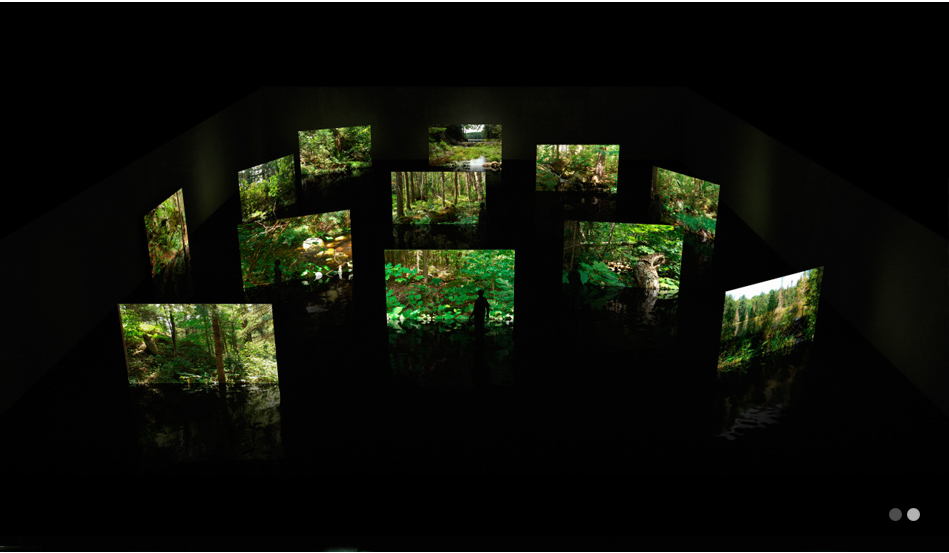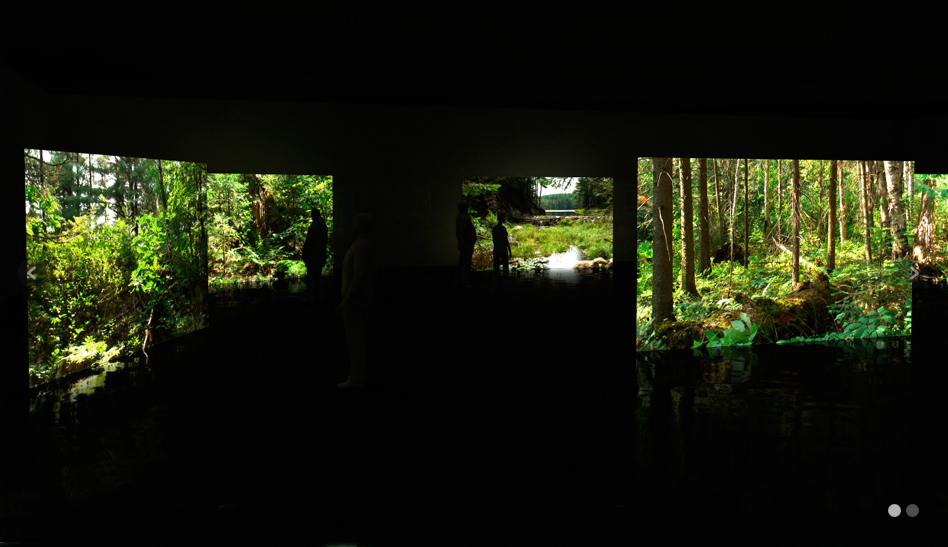Kelly Richardson has been an inspiration to my work in ways i had not though of i didnt think her work was that reverent until i wrote an essay for mixed media and i released she influenced my original idea far more than i had thought. so hears my essay the importent part is the grate destroyer i see my work as the first stages before the grate destroyer and Orion Tide
Kelly Richardson: Life After Nature
Kelly Richardson’s hyper-real digital landscapes are as poignant as they are striking. Working with advanced digital technologies intermingled with a façade of organic landscapes she constructs a distorted intricate imagery that depicts a post-apocalyptic future in which we see the developments of human technologies that have permanently altered the natural state of the organic environment.
The use of large wide screen high-definition video creates immersive filmic installations which evoke a number of emotions, awe, fear and excitement. It can often make you feel like you’re a stranger taking your first steps onto a new planet.
Each space has its unique qualities that create the atmosphere; the polished floors often found in the gallery space create a mirrored image almost like a parallel universe showing a familiar but distorted version of the post apocalyptic imagery above.
“Every space has its own challenges and limitations (budget, size, light bleed, audio bleed, etc.) But white box gallery spaces still offer the best, controlled environments to present the work, where it's not otherwise informed by distractive elements around it or restrictive of how viewers engage with the work as it would be within a cinema, for instance. The works operate like moving paintings or filmic set extensions in a way, without a traditional narrative, inviting the viewer to spend as little or as long with the work as they like.”( http://ca.blouinartinfo.com/news/story/897672/kelly-richardsons-portent-is-having-an-effect) Most films Richardson creates use footage from real landscapes giving each of her films a sense of reality grounding them firmly in the realm of humanity. With no narrative provided it is up to the viewer to create their own story drawing from their past experiences and merging it with the physical landscapes Richardson films to produce an individually crafted narrative.
The Great Destroyer is a series of 7-12 screens hung in a darkened room. As with all of her work we step in to a familiar distorted landscape, in this piece we see details of the Canadian wilderness. Recorded from the depths of the landscape we witness a series of close up footage of lush green inviting habitats. The title is quite ironic, The Great Destroyer implies that something or someone is destroying theses landscapes but humankind has not yet sculpted the landscape for colonization. The sound within this work is essential to the understanding of the piece. The work is woven with natural sounds of the landscape, a mesh of bird’s, insects, frogs and trickling water immerse the senses. As the sounds develop we start to hear the city movements sporadically scattered throughout the landscape, it’s as if humankind are gradually encroaching on the un-spoilt wilderness. as the time passes we are slowly introduced to the sounds of a car alarm and we might even catch the tones of a chainsaw or an echoing of a gun shot interjecting through the natural sounds of the forest. The signs are almost hidden within the sounds very much like the reality of the world around us, as we are not always aware of the alterations we as people are creating within the landscape and hence, the damage we are doing.
By characterization, The Erudition suggests that the spectators are onlookers to a significant message, the identity of the educator and the content of its meaning are left mysteriously open-ended.
The peculiar panorama is supplemented by the sounds crackling noises, as each tree appears into view the loud gentle rumbling of what sounds like wind blowing through an uninhabited space emphasizes the abnormal characteristic of the trees digital disruption.
Each tree fizzles in and out of the film, this being a particularly unnerving vision of nature being apart of faulty software, in turn this makes us hesitant as to whether the trees were once here or are yet to come.
Orion Tide is almost like a commentary to The Great Destroyer In the motionless moments of perpetual twilight, the feeling cannot be shaken that all is not well. The barren landscape is strewn with lifeless undergrowth. The unnerving outburst of sound fills the room creating an uneasy feeling as the gradual upsurge of fire from the sterile landscape pushes forth something deliberately ambiguous. The trail of smouldering ash and fire ascends in to the sky and out of eyesight, as soon as the first has flown the screen, more fly high pushing on up as more and more move forth. Whatever is happening is happening en-masse, this could be missiles being fired from the earth to other parts of the world or through the atmosphere to alien intruders. Conversely with the earth being so desolate, this could be the start of a mass evacuation. When experienced following on after The Great Destroyer it does start to hit home, the destructive nature of humans as a race conquering and colonizing everything we see with little regard for the nature around us. Only when it is gone do we start to see the impact, which we had on the environment.
In the far future one could see works like Richardson’s in 12-floor office building’s across the country with the nature we know today has long since been eroded from the landscape and replaced with man made technology, high rise buildings in a concrete jungle and scientific experiments. The videos she creates are only a view of the nature that was once thriving throughout the earth, now lost to the destructive nature of the human society. In the future this type of installation could be pared with an advanced form of not requiring the use of headphones as it dose today. The immersive nature of binaural sound would add a sense of other worldly reality.
Kelly Richardson’s hyper-real digital landscapes are as poignant as they are striking. Working with advanced digital technologies intermingled with a façade of organic landscapes she constructs a distorted intricate imagery that depicts a post-apocalyptic future in which we see the developments of human technologies that have permanently altered the natural state of the organic environment.
The use of large wide screen high-definition video creates immersive filmic installations which evoke a number of emotions, awe, fear and excitement. It can often make you feel like you’re a stranger taking your first steps onto a new planet.
Each space has its unique qualities that create the atmosphere; the polished floors often found in the gallery space create a mirrored image almost like a parallel universe showing a familiar but distorted version of the post apocalyptic imagery above.
“Every space has its own challenges and limitations (budget, size, light bleed, audio bleed, etc.) But white box gallery spaces still offer the best, controlled environments to present the work, where it's not otherwise informed by distractive elements around it or restrictive of how viewers engage with the work as it would be within a cinema, for instance. The works operate like moving paintings or filmic set extensions in a way, without a traditional narrative, inviting the viewer to spend as little or as long with the work as they like.”( http://ca.blouinartinfo.com/news/story/897672/kelly-richardsons-portent-is-having-an-effect) Most films Richardson creates use footage from real landscapes giving each of her films a sense of reality grounding them firmly in the realm of humanity. With no narrative provided it is up to the viewer to create their own story drawing from their past experiences and merging it with the physical landscapes Richardson films to produce an individually crafted narrative.
The Great Destroyer is a series of 7-12 screens hung in a darkened room. As with all of her work we step in to a familiar distorted landscape, in this piece we see details of the Canadian wilderness. Recorded from the depths of the landscape we witness a series of close up footage of lush green inviting habitats. The title is quite ironic, The Great Destroyer implies that something or someone is destroying theses landscapes but humankind has not yet sculpted the landscape for colonization. The sound within this work is essential to the understanding of the piece. The work is woven with natural sounds of the landscape, a mesh of bird’s, insects, frogs and trickling water immerse the senses. As the sounds develop we start to hear the city movements sporadically scattered throughout the landscape, it’s as if humankind are gradually encroaching on the un-spoilt wilderness. as the time passes we are slowly introduced to the sounds of a car alarm and we might even catch the tones of a chainsaw or an echoing of a gun shot interjecting through the natural sounds of the forest. The signs are almost hidden within the sounds very much like the reality of the world around us, as we are not always aware of the alterations we as people are creating within the landscape and hence, the damage we are doing.
By characterization, The Erudition suggests that the spectators are onlookers to a significant message, the identity of the educator and the content of its meaning are left mysteriously open-ended.
The peculiar panorama is supplemented by the sounds crackling noises, as each tree appears into view the loud gentle rumbling of what sounds like wind blowing through an uninhabited space emphasizes the abnormal characteristic of the trees digital disruption.
Each tree fizzles in and out of the film, this being a particularly unnerving vision of nature being apart of faulty software, in turn this makes us hesitant as to whether the trees were once here or are yet to come.
Orion Tide is almost like a commentary to The Great Destroyer In the motionless moments of perpetual twilight, the feeling cannot be shaken that all is not well. The barren landscape is strewn with lifeless undergrowth. The unnerving outburst of sound fills the room creating an uneasy feeling as the gradual upsurge of fire from the sterile landscape pushes forth something deliberately ambiguous. The trail of smouldering ash and fire ascends in to the sky and out of eyesight, as soon as the first has flown the screen, more fly high pushing on up as more and more move forth. Whatever is happening is happening en-masse, this could be missiles being fired from the earth to other parts of the world or through the atmosphere to alien intruders. Conversely with the earth being so desolate, this could be the start of a mass evacuation. When experienced following on after The Great Destroyer it does start to hit home, the destructive nature of humans as a race conquering and colonizing everything we see with little regard for the nature around us. Only when it is gone do we start to see the impact, which we had on the environment.
In the far future one could see works like Richardson’s in 12-floor office building’s across the country with the nature we know today has long since been eroded from the landscape and replaced with man made technology, high rise buildings in a concrete jungle and scientific experiments. The videos she creates are only a view of the nature that was once thriving throughout the earth, now lost to the destructive nature of the human society. In the future this type of installation could be pared with an advanced form of not requiring the use of headphones as it dose today. The immersive nature of binaural sound would add a sense of other worldly reality.
Twilight Avenger from Kelly Richardson on Vimeo.




 RSS Feed
RSS Feed
